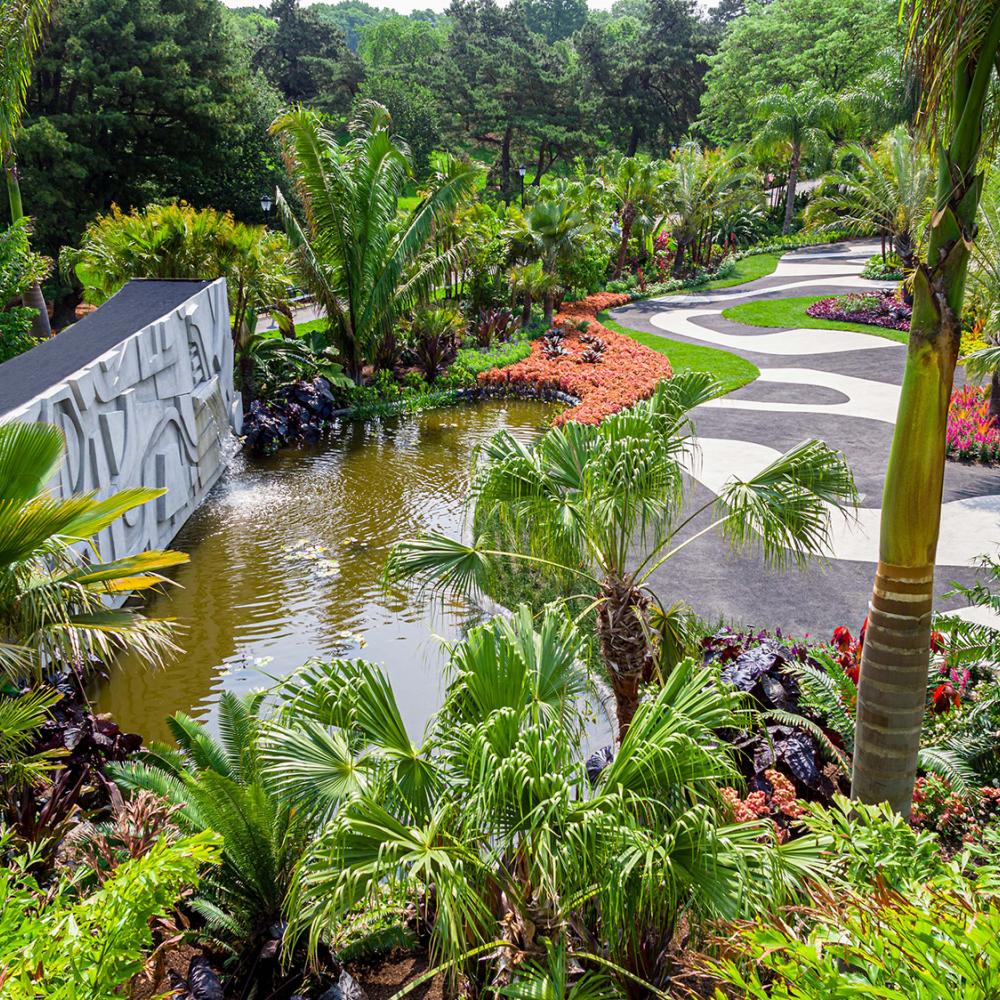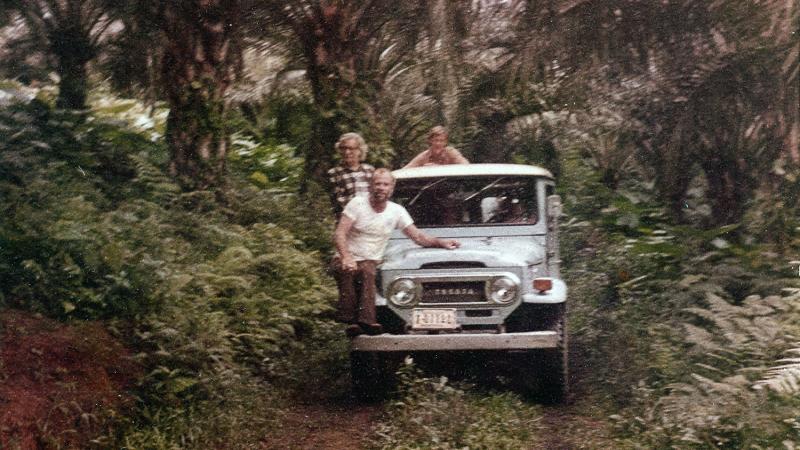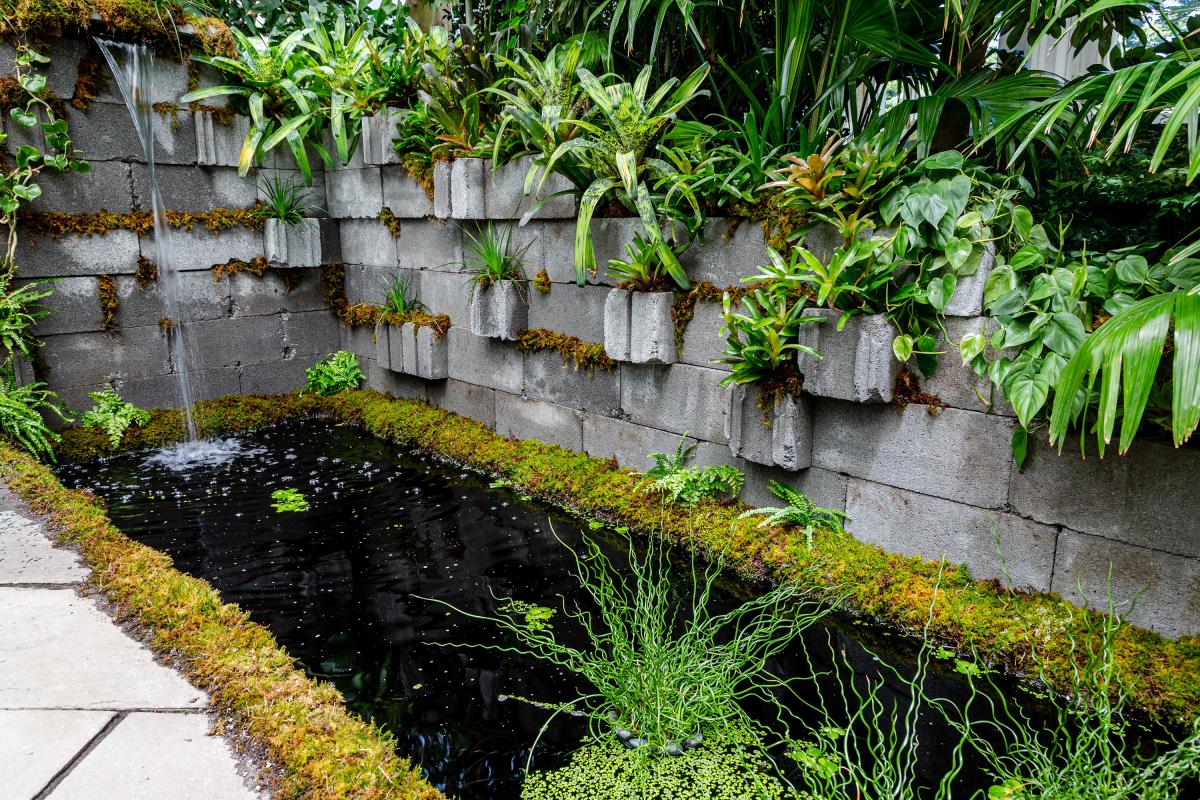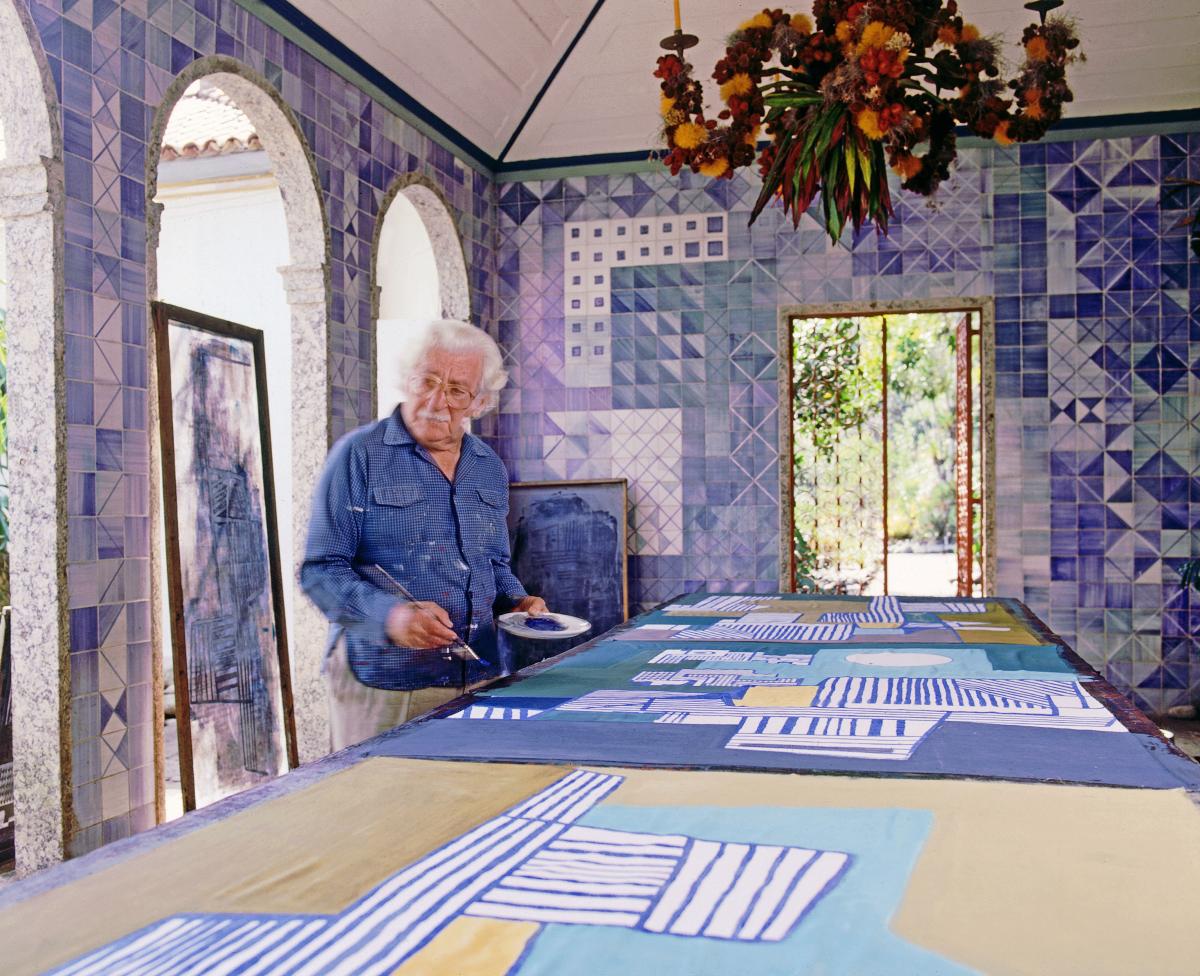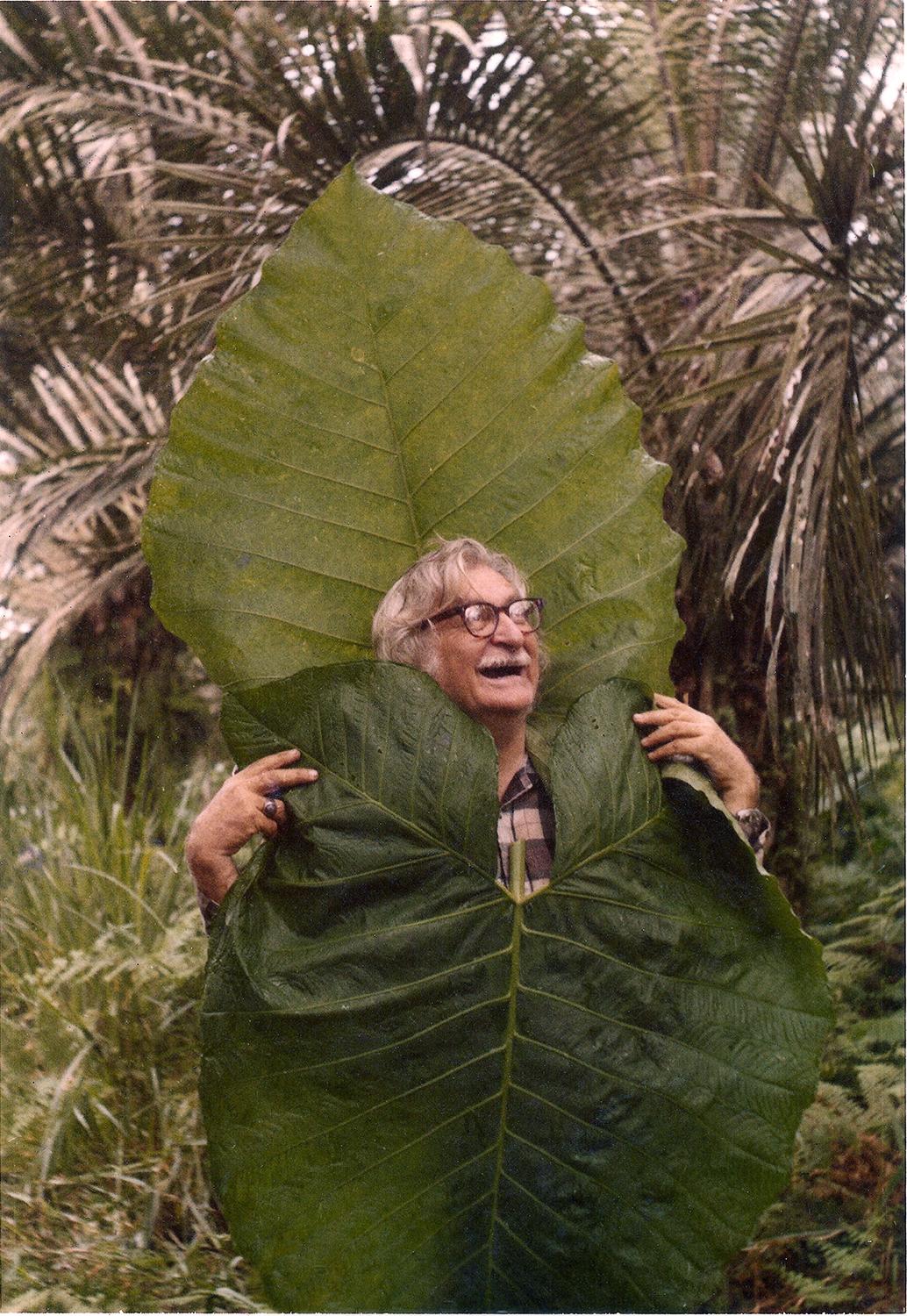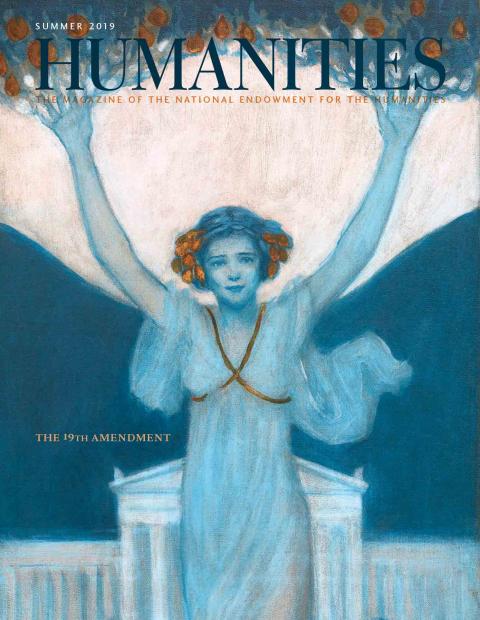Roberto Burle Marx was a seminal figure in twentieth-century landscape design and plant conservation, yet relatively few Americans have heard of him. With its current expansive exhibition, “Brazilian Modern: The Living Art of Roberto Burle Marx,” the New York Botanical Garden is looking to change that. Running through September 29, this multimedia show, funded in part with a grant from the National Endowment for the Humanities, examines the many talents of this extraordinarily versatile artist.
Born in Sao Paulo in 1909, Burle Marx was the child of an immigrant German father and a Brazilian mother of French descent. Raised from the age of four in Rio de Janeiro, Burle Marx absorbed that city’s largely Eurocentric focus. He didn’t seem to question why the boulevards, parks, and gardens were largely planted with imported greenery. It wasn’t until he was nineteen and his family went to Germany for a year that this perspective changed. Perhaps there was an element of homesickness in this epiphany. While learning to sing opera, Burle Marx also studied painting, and, with a sketch pad in hand, began to explore the Brazilian vegetation housed at Berlin’s Dahlem Botanical Garden.
What he learned about Brazil’s plant life was transformative. When the young man returned to Rio, he continued his study of the graphic arts, exploring cubism and modernism at Rio de Janeiro’s Escola Nacional de Belas Artes. Increasingly, however, he became absorbed with the flora of his native country and began collecting and cultivating plants around his home. At age twenty-three he took on his first commission as a landscape designer, creating a garden for a house designed by a pair of prominent avant-garde architects, Lúcio Costa and Gregori Warchavchik. From this came a series of collaborations, and the results were landscapes and gardens that were strikingly different from anything seen before in Brazil, or, in fact, anywhere. Bold, curvilinear beds of tropical foliage and flowers were surrounded and connected with paths that had the sensual swing and rhythm of a samba. With their often outsized, striking foliage, tropical plants served as sculptural elements within these abstract compositions. When the young designer couldn’t find commercial sources for the native plants that inspired him, he began making expeditions himself into the tropical forests to collect and propagate the indigenous vegetation.
Soon his work could be seen all over Brazil, and from there his reach extended to Venezuela, Argentina, Chile, and throughout South America. His growing reputation eventually won him commissions farther afield, in Paris, South Africa, Washington, D.C., Los Angeles, even in Kuala Lumpur, Malaysia. All the while, Burle Marx continued his work in other media: painting and printmaking, designing stage sets and tapestries, and maintaining his interest in musical performance. It is the ambition of the New York Botanical Garden’s exhibition to represent all of Burle Marx’s creative talents, to show not only how they expressed themselves singularly but also how they related and fed each other.
The heart of the show at the New York Botanical Garden is the extensive Brazilian garden installed on a stretch of lawn adjacent to the conservatory, according to the design of Raymond Jungles, an American landscape architect who was a Burle Marx protégé. Assembled with mature specimens of the palms, banana trees, and other tropical vegetation, this display showcases the hot colors and sculptural qualities of the plant life Burle Marx favored. With staging skills worthy of nearby Broadway, NYBG has painted the paths to recall the pedra Portuguesa stone mosaic pavements that were a favored feature in such notable Burle Marx works as the wave-like sidewalks he deployed along Rio’s Copacabana beach. Likewise, the monumental mural and fountain that dominates NYBG’s central plaza may have been fashioned from marine plywood and stucco, but it has the convincingly concrete appearance of the hardscapes Burle Marx created to adorn his own estate and the gardens of clients.
Inside the conservatory there is a second planting, a “Collector’s Garden,” to display the amazing diversity of plants Burle Marx worked with, many of which he himself collected from the wild. Although hardly the first plantsman to investigate Brazil’s forests and jungles, Burle Marx played a considerable role in this process, discovering many species that were still new to science in the twentieth century. Testimony to his success is that some twenty plants from these regions include his name as part of their botanical binomial names. Many more were introduced into cultivation in the nursery and private botanical garden that he established on what is now a 40-acre property where he built his home, the “Sítio,” on the outskirts of Rio de Janeiro. Burle Marx was, however, no mere accumulator of rare plants. Much of the reason he went to the jungle was to observe how the plants grew in their native habitats so that he could reproduce similar conditions and plant combinations in his gardens.
In the courtyard enclosed by the wings of the NYBG conservatory is yet another garden—a water garden of the sort that Burle Marx established for many of his clients. Ablaze with vivid tropical water lily blossoms, the pool is also a temporary home for Victoria amazonica, the so-called “royal water lily,” a native of South America whose leaves can measure nine feet in diameter. Framing the pool are potted palms and a green wall of staghorn ferns.The latter feature is an urban adaptation of a jungle tree dweller and is a piece of whimsy that surely would have pleased Burle Marx.
The Botanical Garden has lined up an impressive schedule of concerts of bossa nova, capoeira, and other performances, which provide a sense of cultural context for Burle Marx’s work. On select Saturdays and Sundays throughout the summer, NYBG will also be hosting a series of award-winning Brazilian films and documentaries in its Ross Hall.
More than just providing context for Burle Marx’s work, though, examples of other arts in this exhibition furnish insights into the landscape architect’s creative process. Exhibited in the art gallery of the Botanical Garden’s LuEsther T. Mertz Library is a collection of Burle Marx’s artworks from the last thirty years of his career, until his death in 1994. This period coincided with his most vigorous period of political activism, when Brazil’s military dominated national politics.
By this time, Burle Marx was internationally famous for his landscape architecture. The right-wing junta that seized power in a coup in 1964 possibly wanted to take advantage of his renown when it appointed Burle Marx to a federal cultural advisory council. This was a period of great productivity for Burle Marx, who cycled through a variety of media, producing both boldly abstract and painstakingly representational works. This dichotomy may seem striking to the observer, but apparently not to Burle Marx, who deliberately compartmentalized his acts of creation.
“If I do gardens,” he explained to one interviewer, “I don’t want to paint; if I do paintings, I don’t want to do woodcuts; if I do prints from woodcuts, I don’t want to do lithography. Each specialty calls for its own technique and medium of expression. . . . I will not do a painting that is a garden.”
Yet one can see how one medium translated to others. There are abstract paintings, for example, with the same kind of energized, biomorphic forms seen in adjacent plans for the rooftop gardens of a bank and the headquarters of the ministry of education and health. Likewise, the interlocking shapes that the visitor recalls from the garden reappear in a tapestry borrowed from the Art Institute of Chicago and in an untitled painting on fabric from a private collection.
In his minutely detailed lithographs of forest and savannah scenes there is an evident affection for the subject, which might have warned Burle Marx’s military sponsors that their appointee would prove troublesome. The catalog for the NYBG exhibition chronicles the landscape architect’s battle to put the brakes on the irresponsible exploitation of Brazil’s wild lands and the squandering of its biological resources. Although he could be, according to contemporary testimony, a somewhat private person, Burle Marx was fearless and publicly vocal in fighting for his homeland’s native flora. In a series of speeches and reports, he combined the insight of an artist with the detailed, factual grasp of a botanist and ecologist. His subjects ranged from the protection of regional ecosystems to the promiscuous felling of street trees, the expropriation of land from a botanical garden to the practice of burning the forest to clear it for agriculture.
“And today,” he thundered in one address to the cultural advisory council, “when I embark on viagens de coleta (collecting trips) in search of material that could serve in the making of my gardens, I see with sorrow and dismay that the destruction is felt wherever one goes. This is a misfortune that seems irreversible, a misfortune that one accepts with melancholy, as if there were no possibility of changing course. If we continue to accept what we are now witnessing, very soon little will remain of this Brazilian flora that is considered one of the richest in the world.”
These were brave words in an era when critics of the regime in Brazil were likely to disappear without a trace. Yet in his advocacy, Burle Marx didn’t waver. He spoke of “the state of emergency . . . of reforestation,” of the need to create “forest reserves” in Amazonia. He called for the establishment of botanical gardens in every Brazilian state, for the creation and expansion of urban parks. Again and again, he decried the horticultural fashion that called for the almost exclusive use of exotic species in gardens and public landscapes.
This was, in many ways, the landscape architect’s finest hour. Through his work, he made native plants sought after. He succeeded, to a surprising degree, in refocusing his fellow Brazilians’ attention on the plants and ecosystems of their homeland, although tragically, the rampant destruction of the natural habitat still continues there.
The power of his words did not stop at the Brazilian border. Evidence accumulates about the negative impacts that environmental degradation is having on many aspects of our health and well-being in the United States as well. Ecologists point to crashing populations of insects and songbirds, the loss of the foundation of our food chain, and attribute this to destruction of their habitats. A new garden ethic is emerging to reverse this decline by emphasizing the use of native plants in our human-populated landscapes. By rediscovering the beauty and resilience of our native flora, by turning each backyard into a tiny bioreserve, we can cumulatively have a major impact. Biodiversity, as Roberto Burle Marx insisted, is in our hands.

